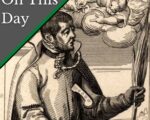
On this day in Tudor history, 4th December 1555, in the reign of Queen Mary I, papal sentence was passed in Rome on Thomas Cranmer, who had served as Archbishop of Canterbury in the reigns of King Henry VIII and King Edward VI.
The papal sentence deprived Cranmer of his archbishopric and gave permission for his fate to be decided by the secular authorities.
Let me explain what led Cranmer to this day and also what happened next…
[Read More...]



